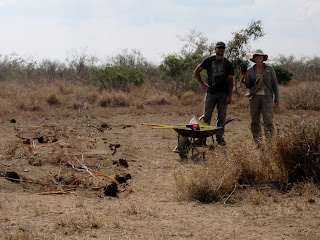SH2015 Gaza Gray was an excavation of an 1850's military outpost probably established on a late Iron Age / historical era native African site.
 |
| signing in at the gate at 5:45 a.m. |
We started each day before dawn leaving our campsite in time to take advantage of our early access privilege into the national park. We could enter before the gates open to the general public at 6:00 a.m. in the winter.
We then picked up Moffat, our dedicated game ranger and drove to the excavation site.
Most of us would then walk the last 300 meters.
 |
| arriving on site |
There are a number of jobs to do every day.
 |
| scraping and digging |
 |
| a double sifter (one fine and one gross mesh) ... |
 |
| to sift the excavated dirt ... |
 |
| ... for artifacts such as pottery shards and bone |
 |
| documenting the finds |
 |
| measuring and delineating the dig site with string |
Even though it was the second week of the excavation, Anton still wanted
to open a third excavation site. I assisted with the measurement and outlying of
the perimeter of the new site.
 |
| photographing the excavations |
Some jobs required advanced skills. Like photographing the completed excavation sites.
The skeletons needed a 90 degree angled aerial photograph with a grid for an accurate rendering before being removed from their resting place.
 |
| the easiest way to photograph at a 90 degree angle |
 |
| the site had to be surveyed in case of future excavation |
And after all the excavations were complete and all the sites were photographed, documented and surveyed, we filled the holes back up again with all the sifted dirt we extracted.
 |
| Anton empties the ceremonial "last bucket" to close SH2015 Gaza Gray |



















No comments:
Post a Comment